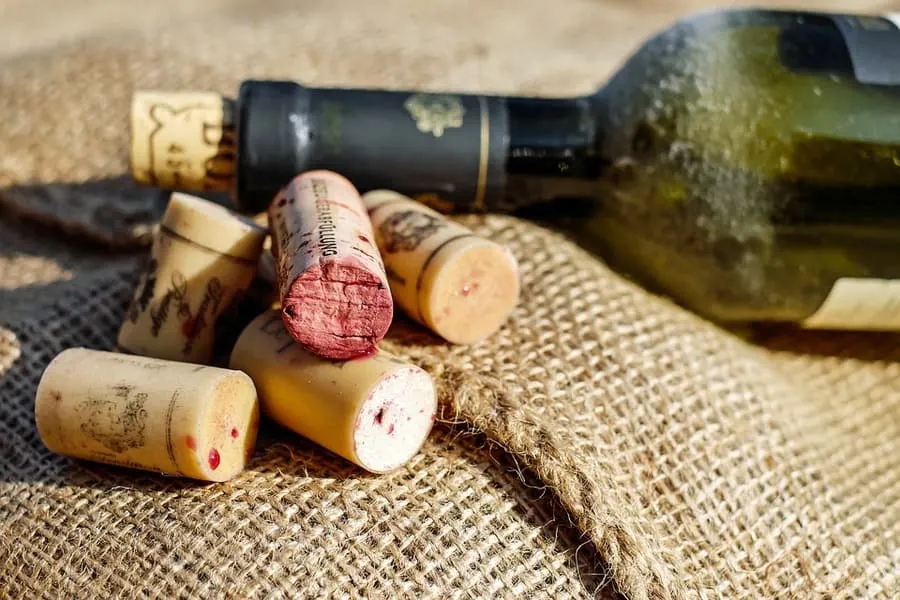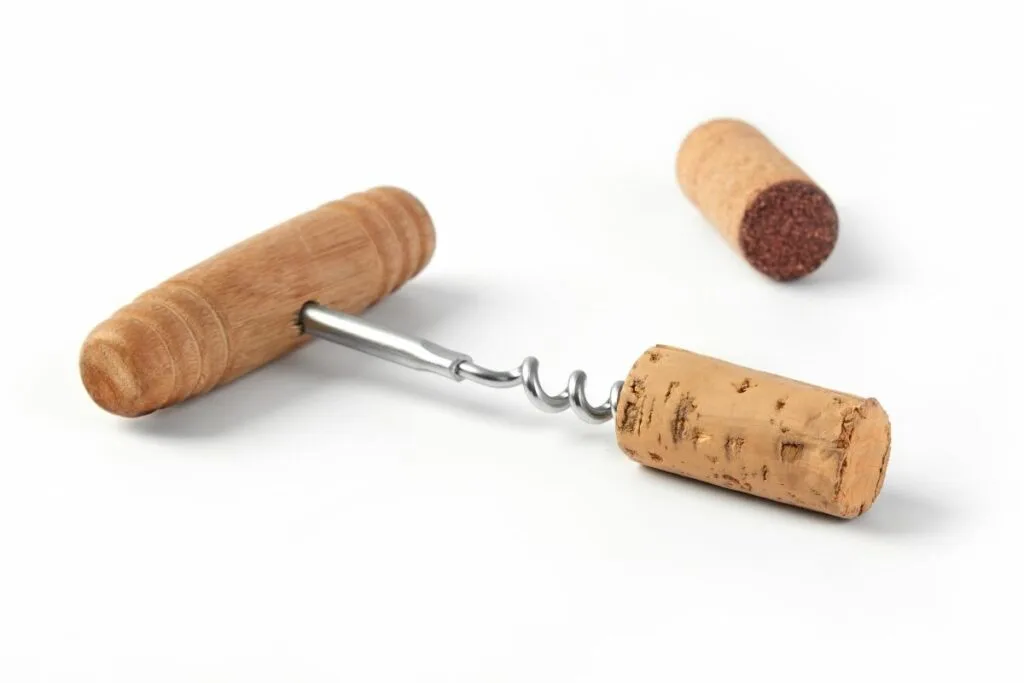As an Amazon Associate, I earn from qualifying purchases with no additional costs for you.
You pull out a fresh bottle of wine for a special occasion, remove the foil, and are greeted by a little patch of mold. You’re probably wondering whether this is a common occurrence and whether the wine inside the bottle is okay.
Do wine corks get moldy, and are they safe? Yes, because wine is stored in a humid environment, the cork of a properly stored bottle of wine may have mold on the outside of it. The wine inside the bottle is perfectly safe to drink, and it will not have any unpleasant flavors caused by the mold on the outside of the cork.
If you’re still not sure, allow us to explain. In this article, we will go over why corks get moldy, how to clean the cork, and other cork problems you might encounter.

TIP: If you want to check out the best refrigerator for wine storage, I recommend trying out the Avation (18 bottles) compressor refrigerator with Wi-fi smart app control cooling system. You can find this refrigerator by clicking here (Amazon link).
Why Do Wine Corks Get Moldy?
Wine corks get moldy for two reasons: cork is a natural material susceptible to mold, and wine is stored in humid, mold-friendly conditions. But honestly, you shouldn’t want it any other way, and here is why.
Why Wine Makers Use Cork
Cork is used for stoppering up bottles of wine because it is a natural material that allows oxygen to enter the bottle at a predictable rate, meaning the wine will age predictably and taste better because of it.
The alternative to natural cork is synthetic cork, and research shows that these corks alter the taste of the wine negatively.
TIP: To find out how long a cork really lasts, read this article. To find out why your wine has turned brown and how to fix it, read this article.
Why Wine is Stored in Humid Conditions
If wine is not stored in humid conditions, the wine cork could dry out, and a dry wine cork could allow air into the wine, causing excessive oxidation.
A wine that is exposed to air will slowly turn to vinegar. So, many argue that a moldy cork is a sign that your wine has been stored properly, and they keep an eye out for moldy corks.
The mold on the cork may be white, furry, black, or mildewy. It is normal and nothing that should make you worry. It will not make you sick, so you should be careful.
For the only 8 steps you need for proper wine storage, click here to read the helpful article I wrote. To learn if you should store wine upright or on its side, you need to learn the material inside this awesome article I published recently.
TIP: Most wines go bad once you pop the cork within a day or so. But a Coravin Wine Preservation system (available for a great price on Amazon) can extend the life of your opened wine for weeks or even months. It is awesome. You should check it out to see if it fits your lifestyle.
Recommendation box: Everything you need to enjoy your wine as much as possible. All recommended products are personally tested and regularly used by experts from this website (Amazon links):
> Ivation Wine Cooler – Energy-efficient wine cooler for 18 bottles with Wi-fi smart app control cooling system.
> Wine Rack – Beautiful, elegant wood rack for up to 7 bottles and the choice of vertical or horizontal storage.
> Durand Wine Opener – Classic vintage wine opener (we like all these classic staff).
> YouYah Iceberg Wine Decanter – The most beautiful and handy wine decanter we personally use.
> Bormioli Rocco Wine Glasses – A set of eight elegant and traditional wine glasses made in Italy.
> Vintorio Wine Aerator – Simple but really useful wine aerator for a reasonable price.
> The Original Vacu Vin Wine Saver – The best wine saver on the market in a package with two vacuum stoppers and two wine servers.
And if you want to become a true connoisseur of wine, we recommend reading the book Wine Folly: The Essential Guide to Wine (Amazon link), where you will find all the information you need about winemaking, wine varieties, flavors, and much more.
How to Clean Mold Off Wine Corks
Cleaning the mold off of a wine cork doesn’t involve any disinfecting chemicals. Simply wipes off the top of the cork with a damp cloth until clean.
When the cork is removed, you can wipe down the mouth of the bottle if it seems a little dirty the same way. It really can be that simple, so don’t overthink this.
If you want to properly cool your wine, a wine fridge is a great investment. This is one of the very best models currently available for a low price on Amazon. It is great for reds, whites, and even sparkling wines like Prosecco. Check it out to read real customer reviews.
Other Problems with Wine Corks
Other cork issues are more problematic than mold that you should look out for when opening a bottle of wine.
- Cracked cork: A cracked cork will cause more air to enter the bottle than should. This will result in a wine that, at best, lacks flavor and, at worst, tastes disgusting.
- Dry cork: a dry cork will let in too much air. The cork should be supple, not hard like a rock.
- Crumbling cork: If a bottle is not stored on its side, the cork can become dried out and crumble. This can result in a wine that “goes bad,” but it isn’t a sure thing. Smell and taste the wine. You will know right away if it isn’t any good but the foul taste. You will need to run the wine through cheesecloth, a coffee filter, or a very fine mesh strainer to remove the pieces of cork.
As you can see, mold is the least of your worries!
TIP: Correct wine storage is essential to keep your wine fresh. Find out here what happens if you store your wine at room temperature. If you don’t have a wine refrigerator, find out how to store wine correctly here.
How to Tell if Wine Has Gone Bad?

First of all, wine doesn’t go bad in the same way that milk goes bad, for instance. If you drink wine that has spoiled, you won’t get sick, at least not because of microorganisms in the wine. So, if you take a sip of spoiled wine, don’t worry that you’ll experience any symptoms.
But the flavor of spoiled wine is another thing and could make you want to be sick. Spoiled wine does not taste as it should, and you will not want to drink it.
Here are the signs of spoiled wine:
- Color: The wine will not be the color you would expect. It tends to turn browner or darker. This
may be harder to tell with deep red wines. - Smell: It may not smell like wine. It could smell sour or pungent.
- Taste: Bad wine does not taste good. If your first sip tastes foul, the wine is bad. You can’t tell by the cork whether a wine has gone bad or not. Why do waiters hand you the cork to examine then? You can tell how the wine was stored by the condition of the cork, which will at least give you an indication of the flavor potential of the wine. However, this is mostly just done as a matter of etiquette.
Smelling the cork is a common practice, but it won’t tell you much about the wine. Most wine enthusiasts feel that corks don’t smell like much.
One of my favorite cork stories was written by Ben Blackburn in Denver Rocky Mountain News:
“Once, I was in a French restaurant that had enough stars to qualify as a minor constellation. The wine came cradled in the tuxedoed arms of a waiter who looked down his considerable nose and presented the bottle with a condescending, ‘Monsieur?’
My host, a cosmopolite who was immune to the hauteur of waiters with accents, ignored the preferred dollop and requested the cork. I half expected him to sniff it, but with a bold look at the wine steward, he raised the cork and put it in his ear. ‘Sounds good,’ he said, nodding sagely. ‘Pour it.’ “
Smelling the cork is a common practice, but it won’t tell you much about the wine. Most wine enthusiasts feel that corks don’t smell like much.
TIP: When and why does wine go bad? Find out here. Can you dispose of old and unopened wine bottles? This article has all the facts.
But What about Cork Taint?

Cork taint is when microorganisms in the cork create flavors and smells in a bottle of wine that is unpleasant. It is different from a bottle of wine going bad, but the result is the same. You’ll be pouring that bottle down the drain because it becomes undrinkable.
Mold on the outside of your cork is not associated with cork taint. There is no way to know if a bottle of wine has cork taint just by looking at it. If there were, people wouldn’t get the rude surprise when they take their first sip!
What Causes Cork Taint?
Whether a bottle is corked will be determined at the moment of bottling, not because of how it is stored or mold that grows on the cork. The microorganisms are present at bottling.
The microorganisms thought to be the cause of cork taint include:
- Penicillium
- Aspergillus
- Cladosporium
- Monilia
- Paecilomyces
- Trichoderma
- Rhodotorula
- Candida yeasts
- Streptomyces bacteria
- Bacillus bacteria
(Source)
The compounds put off by these microorganisms that cause cork taint are:
- 2,4,6-Trichloranisole (responsible for 85% of cork taint)
- Geosmin
- 2-methylisoborneol
- Guaiacol
- 1-octen-3-ol
- 1-octen-3-one
Identifying Cork Taint
Cork taint is identifiable by smelling and tasting the wine. However, sometimes a bottle will smell fine, but it still tastes like it corked, so don’t be surprised if that fine-smelling wine ends up being a disappointing first sip.
How corked wine smells:
- Like a wet dog
- Like a musty, moldy basement
- Like wet cardboard
- Moldy or dank
- Like an old sponge
How corked wine tastes:
- A bottle that is only mildly corked will taste muted and bland.
- A badly corked bottle will taste bad. It leaves no room for doubt.
If a bottle of wine is not stoppered with a natural cork, then it cannot be corked. Synthetic corks do not harbor the microorganisms that cause cork taint. However, any bottle of wine that is stoppered with natural cork, from the most expensive to the least expensive, can cork.
This can be devastating when you open a costly, aged wine, but many high-end wine merchants will accept a return of a wine that has corked as long as the bottle is brought back with the wine still in it.
Is Mold Safe on Wine Bottles?
So, don’t worry about that bit of mold on the cork of your wine bottle. It is an inevitable part of storing and aging wine. But always be on the lookout for deteriorating corks and smell your wine before taking that first sip to ensure you don’t have a corked bottle.
TIP: Check out this page for a complete list of wine products and accessories I love. You’ll find my recommendations for wine refrigerators, decanters, and aerators and the best place to buy wine online. Click here to see the complete listing.
